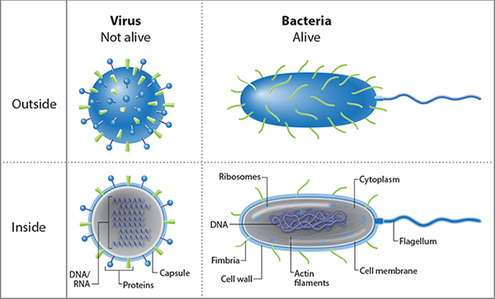We left off with the question: why don’t antibiotics work on viruses? But then I proceeded to "answer" that it was because bacteria are alive and viruses are not. So you were probably thinking, why is she asking that question again? Because I wanted to show this graphic, that’s why!
This chart depicts the main outside and inside components of a virus versus a bacterium. A virus is merely a capsule that carries nuclear information stored in the form of DNA or RNA. A bacterium also carries nuclear information. But here’s the big difference: A bacterium is by definition a cell; it contains all the components to process fuel to support its functions, like getting around to find food or mates, and to make repairs to malfunctioning equipment. It is a self-contained organism that is capable of surviving on its own and “providing” for itself, and therefore has structures (organelles) within to perform these basic functions. Antibiotics disable these critical functions, like the Gyrase enzyme that unwinds the DNA from the previous post. So if the antibiotic can disable that function, the bacterium cannot perform the tasks dictated by that DNA, and it will die.
In contrast, a virus is merely a container for its DNA or RNA. There’s no infrastructure to fix itself, to process fuel, etc. It is NOT a cell, and therefore, not ALIVE. So, knowing that antibiotics mainly cripple a vital function of a cell, how do you go about doing that when that particular function doesn’t exist in your target? And how do you kill something that’s not alive anyway? THAT, is the fundamental reason why antibiotics don’t work on viruses.
Three more questions to follow up from this discussion: 1) Why are viruses so destructive and even deadly, 2) What then, does “inactivate” or get rid of a virus? And 3) I said in the previous post that viral infections once begun often progress to bacterial infections, but why? We’ll cover these topics next!
This chart depicts the main outside and inside components of a virus versus a bacterium. A virus is merely a capsule that carries nuclear information stored in the form of DNA or RNA. A bacterium also carries nuclear information. But here’s the big difference: A bacterium is by definition a cell; it contains all the components to process fuel to support its functions, like getting around to find food or mates, and to make repairs to malfunctioning equipment. It is a self-contained organism that is capable of surviving on its own and “providing” for itself, and therefore has structures (organelles) within to perform these basic functions. Antibiotics disable these critical functions, like the Gyrase enzyme that unwinds the DNA from the previous post. So if the antibiotic can disable that function, the bacterium cannot perform the tasks dictated by that DNA, and it will die.
In contrast, a virus is merely a container for its DNA or RNA. There’s no infrastructure to fix itself, to process fuel, etc. It is NOT a cell, and therefore, not ALIVE. So, knowing that antibiotics mainly cripple a vital function of a cell, how do you go about doing that when that particular function doesn’t exist in your target? And how do you kill something that’s not alive anyway? THAT, is the fundamental reason why antibiotics don’t work on viruses.
Three more questions to follow up from this discussion: 1) Why are viruses so destructive and even deadly, 2) What then, does “inactivate” or get rid of a virus? And 3) I said in the previous post that viral infections once begun often progress to bacterial infections, but why? We’ll cover these topics next!


 RSS Feed
RSS Feed
